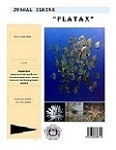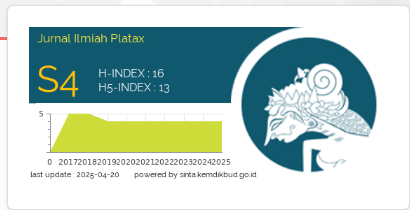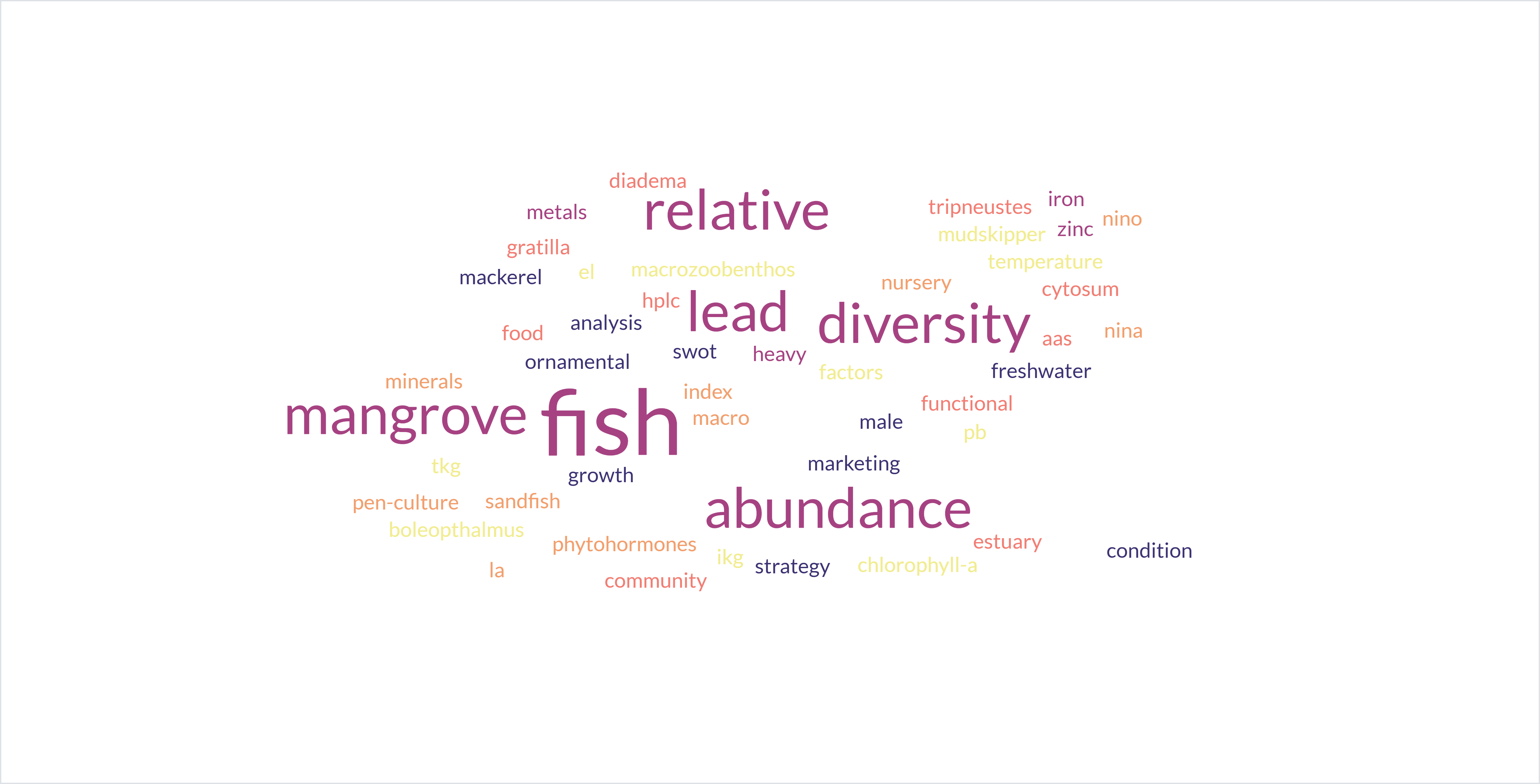Cadmium (Cd) Concentration in Mudskipper, Water and Sediment in the Mangrove Area of Pemangkat West Kalimantan
DOI:
https://doi.org/10.35800/jip.v11i2.49033Keywords:
heavy metal;, cadmium (Cd);, mudskipper;, Pemangkat;, West Kalimantan;Abstract
Mangrove vegetation has a wide range of distribution on the Indonesian coast, including Pemangkat, Sambas Regency, and West Kalimantan. Near this area, there are various activities, such as industrial, fishing, and shipping which are possible sources of heavy metal pollution. Water pollution caused by heavy metals is one of the serious problems. This condition can reduce water quality and has an impact on aquatic organisms. Monitoring of water quality needs to be done to reduce health problems and maintain the stability of aquatic ecosystems. Mudskipper (Boleophthalmus sp.) can be used as a bioindicator due to its ability to accumulate heavy metals from the environment, especially in mangrove areas. Heavy metal such as cadmium (Cd) is difficult to decompose and toxic to the environment and biota. This heavy metal pollution may originate from port and fisheries activities. The aim of this study was to determine the Cd content in the Mudskipper, waters, and sediment samples. Sampling was carried out at two stations. Analysis of the Cd content was done using Atomic Absorption Spectrophotometry (AAS). The result showed that concentrations of Cd in the waters and sediment samples were above the threshold. Meanwhile, the Cd level in Mudskipper flesh was still below the maximum limit.
Keywords: heavy metal, cadmium (Cd), mudskipper, Pemangkat, West Kalimantan
References
Adeboyejo, A.O., Clarke, E.O., Hammed, A.M., & Adaramoye, R.O. (2018). Hematological and Hepatic Responses of the African Catfish Clarias gariepinus to Sublethal Exposure of Industrial Effluents from Ologe Lagoon Environs, Lagos, Nigeria. J. Food Sci. Eng., 8, 198–209. doi:10.17265/2159-5828/2018.05.002
Adeogun, A.O., Ibor, O.R., Omiwole, R., Chukwuka, A.V., Adewale, A.H., Kumuyi, O., & Arukwe, A. (2020). Sex-Differences in Physiological and Oxidative Stress Responses and Heavy Metals Burden in the Black Jaw Tilapia, Sarotherodon melanotheron from a Tropical Freshwater Dam (Nigeria). Comp. Biochem. Physiol. C. Toxicol. Pharmacol., 229, 108676. doi: 10.1016/j.cbpc.2019.108676. Epub 2019 Nov 26.
Al-behbehani, B.E. & Ebrahim, H.M.A. (2010). Environmental Studies on the Mudskippers in the Intertidal Zone of Kuwait Bay. Nat.Sci., 8(5), 79–89.
Ansari, A.A., Trivedi, S., Saggu, S., & Rehman, H. (2014). Mudskipper: A Biological Indicator for Environmental Monitoring and Assessment of Coastal Waters. J. Entomol. Zool., 2(6), 22–33.
AnvariFar, H., Amirkolaie, A.K., Jalali, A.M., Miandare, H.K., Sayed, A.E.D.H., Üçüncü, S., & Romano, N. (2018). Environmental Pollution and Toxic Substances: Cellular Apoptosis as a Key Parameter in a Sensible Model Like Fish. Aquat. Toxicol., 204, 144–159. doi: 10.1016/j.aquatox.2018.09.010.
APHA. (1998). Standard Methods for the Examination of Water and Wastewater. 20th Edition, American Public Health Association, American Water Works Association and Water Environmental Federation, Washington DC.
Association of Official Analytical Chemist (AOAC). (2016). Official Methods of Analysis of Official Analitycal of Chemist. Airlington: The Assoction of Official Analytical Chemists, 18 end Washington DC.
Badan Pusat Statistik Kabupaten Sambas. (2013). Sambas dalam Angka 2012. BPS Sambas.
Barbee, N.C., Ganio, K., & Swearer, S.E. (2014). Integrating Multiple Bioassays to Detect and Assess Impacts of Sublethal Exposure to Metal Mixtures in an Estuarine Fish. Aquat. Toxicol., 152, 244–255. https://doi.org/10.1016/j.aquatox.2014.04.012
Bertrand, L., Monferrán, M.V., Mouneyrac, C., Amé and M.V. (2018). Native crustacean species as a bioindicator of freshwater ecosystem pollution: A multivariate and integrative study of multi-biomarker response in active river monitoring. Chemosphere, 206, 265–277. doi: 10.1016/j.chemosphere.2018.05.00.
Bhuyan, M., Bakar, M., Akhtar, A., Hossain, M., Ali, M., & Islam, M. (2017). Heavy Metal Contamination in Surface Water and Sediment of the Meghna River, Bangladesh. Environmental Nanotechnology, Monitoring & Management, 8, 273–279. https://doi.org/10.1016/j.enmm. 2017.10.003.
Bibak, M., Sattari, M., Agharokh, A., Tahmasebi, S., & Namin, J. (2018). Assessing Some Heavy Metals Pollutants in Sediments of The Northern Persian Gulf (Bushehr Province). Environmental Health Engineering and Management Journal, 5, 175-179. doi:10.15171/EHEM.2018.24
Bouzahouane, H., Barour, C., Sleimi, N., & Ouali K. (2018). Multi-biomarkers Approach to the Assessment of the Southeastern Mediterranean Sea health status: Preliminary Study on Stramonita Haemastoma used as a Bioindicator for Metal Contamination. Chemosphere, 207, 725–741. https://doi.org/10.1016/j.chemosphere.2018.05.118.
Buhari, T.R. & Ismail, A. (2016). Correlations between Geo-Chemical Speciation of Heavy Metals (Cu, Zn, Pb, Cd and Ni) in Surface Sediments and Their Concentrations in Giant Mudskipper (Periophthalmodon schlosseri) Collected from the West Coast of Peninsular Malaysia. GEP., 04(01), 28–36. doi: 10.4236/gep.2016.41003.
Çoban, B., Balkis, N., & Aksu, A. (2009). Heavy Metal Level in Sea Water and Sediments of Zonguldak, Turkey. J. Black Sea Mediterranean Environment, 15, 23-32.
Dabruzzi, T.F., Fangue, N.A., Kadir, N.N., & Bennett, W.A. (2019). Thermal Niche Adaptations of Common Mudskipper (Periophthalmus kalolo) and Barred Mudskipper (Periophthalmus argentilineatus) in Air and Water. J. Therm. Biol., 81, 170–177. https://doi.org/10.1016/ j.jtherbio.2019.02.023.
Dahuri, R. (2003). Keanekaragaman Hayati Laut: Aset Pembangunan Berkelanjutan Indonesia. Jakarta: PT. Gramedia Pustaka Utama.
Dange, S. & Manoj, K. (2015). Bioaccumulation of Heavy Metals in Sediment, Polychaetes (Annelid) Worms, Mud Skipper and Mud Crab at Purna River Estuary, Navsari, Gujarat, India. International Journal of Current Microbiology and Applied Sciences, 4(9): 571–575.
de Almeida Duarte, L.F., de Souza, C.A., Pereira, C.D.S., & Pinheiro, M.A.A. (2017). Metal Toxicity Assessment by Sentinel Species of Mangroves: In Situ Case Study Integrating Chemical and Biomarkers Analyses. Ecotoxicol. Environ. Saf., 145: 367–376. doi: 10.1016/j.ecoenv.2017.07.051
Di Bella, G., Potortì, A.G., Turco, V.L., Bua, D., Licata, P., Cicero, N., & Dugo, G. (2015). Trace Elements in Thunnus thynnusfrom Mediterranean Sea and Benefit–risk Assessment for Consumers. Food Addit. Contam., 8, 175–181. DOI:10.1080/19393210.2015.1030347.
Fadhlin, A. (2019). Analisis Logam Berat Timbal (Pb) dan Kadmium (Cd) pada Ikan Gulamah (Johnius belangerii) di Perairan Belawan Provinsi Sumatera Utara. Departemen Manajemen Sumber Daya Perairan, Fakultas Pertanian, Universitas Sumatera Utara. [Skripsi].
Finlayson, C.M., Horwitz, P., & Weinstein, P. (2015). Wetlands and Human Health, Netherlands.
Froese, R. & Pauly, D. Editors. (2022). FishBase. Boleopthalmus. Accessed through: World Register of Marine Species at: https://www.marinespecies.org/aphia.php?p= taxdetails&id=296174 on 2022-11-24.
Georgieva, E., Yancheva, V., Velcheva, I., Iliev, I., Vasileva, T., Bivolarski, V., & Stoyanova, S. (2016). Histological and Biochemical Changes in Liver of Common Carp (Cyprinus carpio L.) under Metal Exposure. North-West. J. Zool., 12(2), 261–270.
Gu, Y.G., Wang, X.N., Lin, Q., Du, F.Y., Ning, J.J., Wang, L.G., & Li, Y.F. (2016). Fuzzy Comprehensive Assessment of Heavy Metals and Pb Isotopic Signature in Surface Sediments from A Bay Under Serious Anthropogenic Influences: Daya Bay China. Ecotoxicology Environmental Safety, 126, 38-44. https://doi.org/10.1016/j.ecoenv. 2015.12.011.
Gu, Y.G. & Lin, Q. (2016). Trace Metals in A Sediment Core from The Largest Mariculture Base of The Eastern Guangdong Coast South China: Vertical Distribution, Speciation, and Biological Risk. Marine Pollution Bulletin, 113, 520-525. doi:10.1016/j.marpolbul. 2016.08.029
Han, Y.L., Sheng, Z., Liu, G. Di., Long, L.L, Wang, Y.F., Yang, W.X., & Zhu, J.Q. (2015). Cloning, Characterization and Cadmium Inducibility of Metallothionein in the Testes of the Mudskipper Boleophthalmus pectinirostris. Ecotoxicol. Environ. Saf., 119, 1–8. doi: 10.1016/j.ecoenv. 2015.04.055
Hasan, M., Khan, M.Z., Khan, M., Aktar, S., Rahman, M., Hossain, F., & Hasan, A.S.M. (2016). Heavy Metals Distribution and Contamination in Surface Water of the Bay of Bengal Coast. Cogent Environmental Science, 2(1), 1–12. https://doi.org/10.1080/23311843.2016. 1140001.
Haq-Nawaz, B., Rubina, K., & Muhammad, A.H. (2011). Biosorption of Pb (II) and Co (II) on Red Rose Waste Biomass. Iranian Journal of Chemistry and Chemical Engineering (IJCCE), 30, 81-7. doi.org/ 10.30492/ijcce.2011.6093.
Hermenean, A., Gheorghiu, G., Stan, M.S., Herman, H., Onita, B., Ardelean, D.P., Ardelean, A., Braun, M., Zsuga, M., & Kéki, S. (2017). Biochemical, Histopathological and Molecular Responses in Gills of Leuciscus cephalus Exposed to Metals. Arch. Environ. Contam. Toxicol., 73, 607–618. doi: 10.1007/s00244-017-0450-5.
Hidayaturrahmah, Mabrur, Santoso, H.B., Sasmita, R., Rahmy, U.S.A., & Badruzsaufari. (2019). Protein Profiles of Giant Mudskipper and Its Potential Use as Biomarker Candidate for Heavy Metal Contamination in Barito Estuary, Indonesia. Biodiversitas, 20(3), 745–753.
Ikram, M.M., Ismail, A., Yap, C.K., & Nor Azwady, A.A. (2010). Levels of Heavy Metals (Zn, Cu, Cd, and Pb) in Mudskippers (Periophthalmodon schlosseri) and Sediments Collected from Intertidal Areas at Morib and Remis, Peninsular Malaysia. Toxicol Environ Chem., 92(8), 1471–1486. https://doi.org/10.1080/02772241003614304.
Javed, H., Islam, A., Chauhan, A., Kumar, S., & Kumar, S. (2018). Efficacy of engineered GO Amberlite XAD-16 picolylamine sorbent for the trace determination of Pb (II) and Cu (II) in fishes by solid phase extraction column coupled with inductively coupled plasma optical emission spectrometry. Sci. Rep., 8,17560. doi: 10.1038/s41598-018-35656-1.
Kaur, S., Khera, K., & Kondal, J. (2018). Heavy metal induced histopathological alterations in Liver, Muscle and Kidney of Freshwater Cyprinid, Labeo rohita (Hamilton). Journal of Entomology and Zoology Studies, 6(2), 2137–2144.
Khan, M., Ding, X., Khan, S., Brusseau, M., Khan, A., & Nawab, J. (2018). The Influence of Various Organic Amendments on the Bioavailability and Plant Uptake of Cadmium Present in Mine-Degraded Soil. Science of the Total Environment, 636, 810–817. https://doi. org/10.1016/j.scitotenv.2018.04.299.
Kordi, G.M. (2012). Ekosistem Mangrove: Potensi, Fungsi dan Pengelolaan. Jakarta: Rineka Cipta.
Lata, G., Chari, H.N.V., Sarma, V.V., & Ingole, B. (2013). Variation in Heavy Metals Concentration in the Edible Oyster Crassostrea madrasensis, Clam Polymesoda erosa and Grey Mullet Liza aurata from Coastline of India. Indian Journal of Science, 2, 59-63. http://drs.nio.org/drs/handle/2264/4252
Liu, Q., Xu, X., Zeng, J., Shi, X., Liao, Y., Du, P., & Shou, L. (2019). Heavy Metal Concentrations in Commercial Marine Organisms from Xiangshan Bay, China, and the Potential Health Risks. Mar. Pollut. Bull., 141(36), 215–226. https://doi.org/10.1016/ j.marpolbul.2019.02.058.
Male, Y., Malle, D., Bijang, C., Fransina, E., Seumahu, C., Dolaitery, L., Landu, S., & Gaspersz, N. (2017). Analysis of Cadmium (Cd) and Lead (Pb) Metals Content on Sediment Inner Part of Ambon Bay. Journal of Chemical Research, 5(1), 22–31. https://doi. org/10.30598//ijcr.2017.5-yus.
Marques, D.S., Patrícia, G.C., Gustavo, M.S., Janaína, G.C., Indianara, F.B., & Adalto, B. (2019). Selection of Biochemical and Physiological Parameters in the Croaker Micropogonias furnieri as Biomarkers of Chemical Contamination in Estuaries using a Generalized Additive Model (GAM). Science of the Total Environment, 647(1), 1456–1467. doi: 10.1016/j.scitotenv.2018.08.049
Naccari, C., Cicero, N., Ferrantelli, V., Giangrosso, G., Vella, A., Macaluso, A., Naccari, F., & Dugo, G. (2015). Toxic Metals in Pelagic, Benthic and Demersal Fish Species from Mediterranean FAO Zone 37. Bull. Environ. Contam. Toxicol., 95, 567–573. doi: 10.1007/s00128-015-1585-6.
Nagelkerken, I., Blaber, S.J.M., Bouillon, S., Green, P., Haywood, M., Kirton, L.G., Meynecke, J.-O., Pawlik, J., Penrose, H.M., Sasekumar, A., Somerfield, P.J. (2008). The Habitat Function of Mangroves for Terrestrial and Marine Fauna: A review. Aquatic Botany, 89(2), 155-185. https://doi.org/10.1016/j.aquabot.2007.12.007
Nanami, A. & Takegaki, T. (2005). Age and growth of the mudskipper Boleophthalmus pectinirostris in Ariake Bay, Kyushu, Japan. Fisheries Research, 74: 24–34. doi:10.1016/j.fishres.2005.04.005.
Nemmiche, S. (2017). Oxidative Signaling Response to Cadmium Exposure. Toxicol. Sci., 156(1), 4–10. doi: 10.1093/toxsci/kfw222.
Nugraha, W.A. (2009). Kandungan Logam Berat Pada Air dan Sedimen di Perairan Socah dan Kwanyar Kabupaten Bangkalan. Jurnal Kelautan, 2, 1907-9931. DOI: https:// doi.org/10.21107/jk.v2i2.863
Okafor, E. & Opuene, K. (2007). Preliminary Assessment of Trace Metals and Polycyclic Aromatic Hydrocarbons in the Sediments. International Journal of Environmental Science and Technology, 4, 233-240.
Ouedraogo, M., Baudoux, T., Stévigny, C., Nortier, J., Colet, J.-M., Efferth, T., Qu, F., Zhou, J., Chan, K., Shaw, D., Pelkonen, O., Duez, P. (2012). Review of Current and ‘Omics’ Methods for Assessing the Toxicity (Genotoxicity, Teratogenicity and Nephrotoxicity) of Herbal Medicines and Mushrooms. J. Ethnopharmacol., 140(3), 492–512. https:// doi.org/10.1016/j.jep.2012.01.059
Pekey, H. (2006). Heavy Metals Pollution Assessment in Sediments of The Izmit Bay, Turkey. Environmental Monitoring and Assessment, 123, 219-231. DOI:10.1007/s10661-006-9192-y
Peraturan Pemerintah Nomor 22 Tahun 2021 tentang Penyelenggaraan Perlindungan dan Pengelolaan Lingkungan Hidup [JDIH BPK RI] LN.2021/No.32, TLN No.6634, jdih.setkab.go.id: 374 hlm.
Polgar, G. (2010). Mudskippers: An Introduction for Aquarists. Conscientious Aquarist Magazine, 1–14.
Prabowo, R., Purwanto, & Sunoko, H.R. (2016). Akumulasi Cadmium (Cd) pada Ikan Wader Merah (Puntius bramoides C.V), di Sungai Kaligarang. Jurnal MIPA, 39(1), 1-10.
Putra, C., Siregar, Y., & Anita, S. (2013). Kandungan Logam Berat Kadmium (Cd) dan Timbal (Pb) Pada Sedimen, Air dan Ikan Tembakul (Periophthalmus sp.) di Perairan Dumai. Pusat Penelitian Lingkungan Hidup Universitas Riau, 1, 5-24.
Rahimzadeh, M.R., Rahimzadeh, M.R., Kazemi, S., Moghadamnia, A.A. (2017). Cadmium Toxicity and Treatment: An Update. Caspian J. Intern. Med., 8, 135–145. doi 10.22088/cjim.8.3.135
Rangkuti, A.M., Cordova, M.R., Rahmawati, A., Yulma, Adimu, H.E. (2017). Ekosistem Pesisir & Laut Indonesia. Jakarta: Bumi Aksara. 482 pp.
Renieri, E., Alegakis, A., Kiriakakis, M., Vinceti, M., Ozcagli, E., Wilks, M., & Tsatsakis, A. (2014). Cd, Pb and Hg Biomonitoring in fish of the Mediterranean Region and Risk Estimations on Fish Consumption. Toxics, 2(3), 417–442. https://doi.org/10. 3390/toxics2030417.
Rodriguez, A., Kildegaard, K.R., Li, M., Borodina, I., & Nielsen, J. (2015). Establishment of a Yeast Platform Strain for Production of p-coumaric Acid Through Metabolic Engineering of Aromatic Amino Acid Biosynthesis. Metabolic Engineering, 31, 181-188. https://doi.org/10.1016/j.ymben. 2015. 08.003
Sahara, E. (2009). Distribusi Pb dan Cu pada Berbagai Ukuran Partikel Sedimen di Pelabuhan Benoa, Bali. Jurnal Kimia, 2, 75-80.
Salgado, L.D., Marques, A.E.M.L., Kramer, R.D., Oliveira, F.G de., Moretto, S.L., Lima, B.A. de Silva, & de Assis, H.C. (2019). Integrated Assessment of Sediment Contaminant Levels and Biological Responses in Sentinel Fish Species Atherinella brasiliensis from a Sub-Tropical Estuary in South Atlantic. Chemosphere, 15–27. doi: 10.1016/ j.chemosphere.2018.11.204.
Sangur, K., Leiwakabessy, F., Tuaputty, H., Tuwankotta, L.V., Samloy, S.V., Ratila, C., Salakory, O.B., Matulessy, C., Rumahlatu, D. (2021). Mudskipper as an Indicator Species for Lead, Cadmium and Cuprum Heavy Metal Pollution in the Mangrove, Ambon, Indonesia. Journal of Ecological Engineering, 22(4), 1–19. DOI: https:// doi.org/10.12911/22998993/134077.
Santoso, H.B., Suhartono, E., Yunita, R., & Biyatmoko, D. (2020). Mudskipper Fish as a Bio-indicator for Heavy Metals Pollution in a Coastal Wetland. Egyptian Journal of Aquatic Biology & Fisheries, 24(7), 1073–1095. DOI:10.21608/ejabf.2020.144402.
Santoso, H.B., Hidayaturrahmah, Suhartono, E., Yunita, R., Biyatmoko, D., & Anggraini, D. (2021). Heavy Metal Concentrations in Water, Sediment and Giant Mudskipper (Periophthalmodon schlosseri) in the Coastal Wetlands of Kuala Lupak Estuary of the Barito River, Indonesia. AACL Bioflux, 14(5), 2878–2893. http://www.bioflux.com.ro/aacl.
Saputro, GB., Hartini, S., Sukardjo, S., Susanto, AI., & Poniman, A. (2009). Peta Mangroves Indonesia. Pusat Survey Sumber Daya Alam Laut, Badan Koordinasi Survey dan Pemetaan Nasional (BAKOSURTA-NAL). 329 hlm.
Sarah, R., Baby, T., Nida, I., Abeer, H., & Elsayed, F.A.A. (2019). Bioaccumulation of Heavy Metals in Channa punctatus (Bloch) in River Ramganga (U.P.), India. Saudi Journal of Biological Sciences, 26(5), 979–984. https://doi.org/10.1016/j.sjbs.2019.02.009.
Shah, N., Khan, A., Ali, R., Marimuthu, K., Uddin, M.N., Rizwan, M., Rahman, K.U., Alam, M., Adnan, M., & Muhammad. (2020). Monitoring Bioaccumulation (in Gills and Muscle Tissues), Hematology, and Genotoxic Alteration in Ctenopharyngodon idella Exposed to Selected Heavy Metals. BioMed Res. Int., 2020, 6185231. DOI: 10.1155/2020/6185231
Sia Su, G.L., Gliceria, B.R., & Maria, L.L.S.S. (2013). Bioaccumulation and Histopathological Alteration of Total Lead in Selected Fishes from Manila Bay, Philippines. Saudi Journal of Biological Sciences, 20(4), 353–355. DOI: 10.1016/j.sjbs.2013.03.003
Sinha, A.K., Romano, N., Shrivastava, J., Monico, J., & Bishop, W.M. (2020). Oxidative Stress, Histopathological Alterations and Anti-Oxidant Capacity in Different Tissues of Largemouth Bass (Micropterus salmoides) Exposed to a Newly Developed Sodium Carbonate Peroxyhydrate Granular Algaecide Formulated with Hydrogen Peroxide. Aquat Toxicol., 218, 105348. https://doi.org/10.1016/j.aquatox.2019.105348
Şireli, U.T., Göncüoğlu, M., Yildirim, Y., Gücükoğlu, A., & Çakmak, Ö. (2006). Assessment of Heavy Metals (Cadmium and Lead) in Vacuum Packaged Smoked Fish Species (Mackerel, Salmo salar and Oncorhynhus mykiss) Marketed in Ankara (Turkey). Journal of Fisheries & Aquatic Sciences, 23(3–4), 353–356.
Siska, I.M. (2008). Korelasi Antara Kedalaman Sedimen di Pelabuhan Benoa dan Konsentrasi Logam Berat Pb dan Cu. Jurnal Kimia, 2, 61-70.
Souisa, G. (2017). Konsentrasi Logam Berat Cadmium dan Timbal pada Air dan Sedimen di Teluk Ambon. Tunas-Tunas Riset Kesehatan, 7(1), 1–7.
Tabrez, S., Torki, A.Z., & Mehjbeen, J. (2021). Bioaccumulation of Heavy Metals and Their Toxicity Assessment in Mystus Species. Saudi Journal of Biological Sciences, 28(2), 1459–1464. https://doi.org/10.1016/j.sjbs.2020.11.085
Tchounwou, P.B., Yedjou, C.G., Patlolla, A.K., & Sutton, D.J. (2012). Heavy Metal Toxicity and the Environment. Exp Suppl., 101, 133-64. doi: 10.1007/978-3-7643-8340-4_6.
WHO. (2008). The Global Burden of Diseases: 2004 Update Geneva: World Health Organization. http://www.who.int/healthinfo/global_burden_disease/GBD_report_2004 update_full.pdf.
Ziyaadini M., Yousefiyanpour Z., Ghasemzadeh J., & Zahedi M.M. (2017). Biota-sediment accumulation factor and concentration of heavy metals (Hg, Cd, As, Ni, Pb and Cu) in sediments and tissues of Chiton lamyi (Mollusca: Polyplacophora: Chitonidae) in Chabahar Bay, Iran. Iranian Journal of Fisheries Sciences, 16(4), 1123-1134.
Downloads
Published
How to Cite
Issue
Section
License
Copyright (c) 2023 Nurhidayanti Nurhidayanti, Mega Sari Juane Sofiana, Ikha Safitri

This work is licensed under a Creative Commons Attribution-NonCommercial 4.0 International License.
COPYRIGHT
Authors who publish with this journal agree to the following terms:
Authors hold their copyright and grant this journal the privilege of first publication, with the work simultaneously licensed under a Creative Commons Attribution License that permits others to impart the work with an acknowledgment of the work's origin and initial publication by this journal.
Authors can enter into separate or additional contractual arrangements for the non-exclusive distribution of the journal's published version of the work (for example, post it to an institutional repository or publish it in a book), with an acknowledgment of its underlying publication in this journal.
Authors are permitted and encouraged to post their work online (for example, in institutional repositories or on their website) as it can lead to productive exchanges, as well as earlier and greater citation of the published work (See The Effect of Open Access).






































